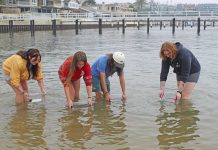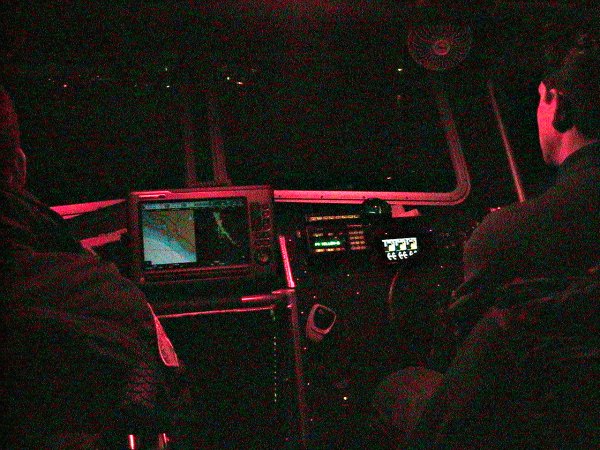
You may have heard the news recently. Mexican smugglers, known as “coyotes” are turning increasingly to California’s southern coastline as a new and more effective means of getting their contraband into the United States. The trend, experts say, is fueled by the increased difficulty of making a successful illegal crossing from Mexico into the United States by land, due to stepped up U.S. border enforcement in recent years.
The primary contraband of the smugglers are men, women and children, as well as drugs. All are now flowing north out of Mexico and onto the beaches of Southern California, from San Diego to Santa Barbara. Orange County and Newport Beach are not immune from the influx. Smuggling is now not just a border-town problem.
The smugglers’ vessel of choice is known as a “panga,” a small but study Mexican fishing boat famous for its hardiness. The open wood –and-fiberglass boats are made in Mexico. Although extremely sturdy, the outboard-motor-run boats were not designed or meant to be used in the open ocean for extended periods.
They also have one very dangerous flaw, they sink like a rock if they take on water. That is a potentially fatal problem for the people on board the boats, as they’re taken far offshore by their smuggler captains in the attempt to evade U.S. authorities.
But that hasn’t stopped the ocean going “coyotes” – smugglers – from playing a life-and death-game of high-seas hide-and-seek with U.S. officers.
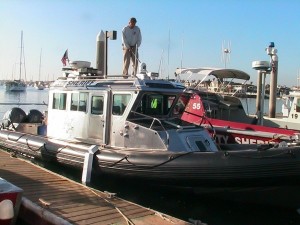
This year alone, there have already been 92 events, 307 apprehensions and 50 seizures off the California coast, according to figures provided by the U.S. Border Patrol. In 2011, according to the same statistics, there were 183 events with 631 apprehensions and 122 seizures. And 2010 was little better, with 123 events and 867 apprehensions and 110 seizures. In addition, six people have lost their lives trying to be smuggled illegally into the U.S. by sea.
Stories of panga landings along the Southern California coast have become almost commonplace. A special task force set up by federal, state and local authorities, dubbed the San Diego Regional Coordination Mechanism (ReCom) is a coordinated effort trying to stem the tide of illegal aliens and drugs coming ashore. Southern California’s hundreds of miles of potential beach drop-off points include many beaches right here in Orange County and along the Newport Beach coastline.
Last month, 14 suspected illegal aliens were arrested after their panga boat washed ashore in Huntington Beach. Last July a Mexican panga with nearly a dozen suspected illegal aliens came ashore at Crystal Cove state park in Newport Beach in the early morning hours.
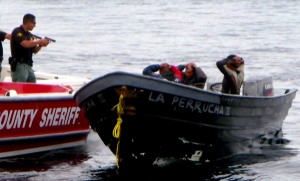
This past August, another panga loaded with suspected illegal aliens were arrested near Magnolia Street in Huntington Beach. In that case, the panga tried to flee but was chased down by a Harbor Patrol boat about a mile off the Newport Beach Pier. Three suspected smugglers were arrested.
Here in Newport Beach, the Orange County Sheriff Department (OCSD) bases it operations at its Corona del Mar headquarters off Bayside Drive near Balboa Island. Led by Harbormaster Lt. John Slayton, the OCSD has maritime bases in Newport, Huntington and Dana Point. It patrols the waters offshore from the southern tip of Orange County off San Clemente to its northernmost point near Seal Beach. The patrols go as far out to sea as Catalina Island, 26 miles off the coast.
As an integral part of the on-going anti-smuggling operations, the OCSD Harbor Patrol in Newport Beach has utilized a federal grant program dubbed “Operation Stonegarden.” The federal program began in 2009 and was set up to assist local and state law enforcement agencies in border states with funding for border protection-specific operations and costs. The OCSD has received nearly $1.4 million in federal funds from the program since 2009 according to department disclosures.
Part of that money, nearly $400,000, was used to purchase a new high-tech patrol boat put into service in December at the OCSD’s Newport Beach headquarters. The boat, known as a SAFE Defender 33, is a high-tech patrol boat that is dedicated and funded to conduct Operation Stonegarden patrol missions. The boat is laden with high-tech systems like Forward Looking Infrared Radar (FLIR), which can see boats and other objects in the ocean in the pitch dark.
Last week, the Independent was granted special access to tag along with an overnight Stonegarden patrol out of Newport Beach. The mission had a simple purpose, to detect and interdict any smuggling activity that might be taking place off the coast. The Mexican panga boats mostly operate at night, under the cover of darkness. On this night their adversaries were out to catch them in a game of high seas cat and mouse.
Watch a video of the Panga Patrol here.
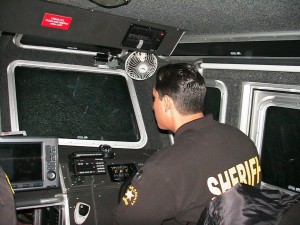
At a little after 11 p.m. I met the crew of this night’s mission: OC Sheriff’s Deputies Anthony Larios and Eric King, both assigned to the Harbor Patrol base in Newport. Rounding out the three-person team, Agent Jose Pineda of the U.S. Border Patrol arrived from San Clemente .
All the officers involved in Stonegarden patrol missions are volunteers. I was told that the special nature of the clandestine missions themselves, as well as the overtime pay the special duty provided, was what motivated participants to take part.
With Anthony at the helm of our sleek aluminum jet-like patrol boat, we shoved off from the Harbor Patrol docks about 11:30 p.m. and headed out to sea. We passed Newport’s famed Wedge and Pirate’s Cove under a full moon. As we rounded the last rocks of the jetty we headed north along the coastline looking for suspicious activity and any boats plying the waters in the middle of the night.
The job of tracking “contacts” on the FLIR screen was primarily Eric’s. Both Anthony’s and Eric’s heads would for hours be alternating between two screens and peering into the near pitch black ocean for anything that seemed suspicious. Anthony’s primary job was making sure the swell didn’t extract a toll on the boat or our necks as we reached speeds of over 40 knots flying across the waves in the dead of night.
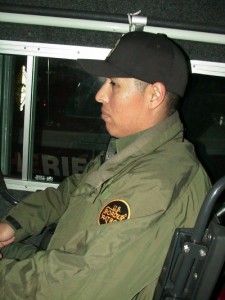
The ocean itself always has a say in these type of missions, and on this night the swells were running 3 to 5 feet and a stiff cold wind was making our ride somewhat less than smooth sailing. Anthony, I could see, was an old hand at making sure this new high-speed patrol boat didn’t end up on the wrong side of rogue swell.
As we flew across the waves the search began in earnest.
Not long after we passed the Balboa Pier, Eric spotted a boat on the radar and we took off after it. As we closed in on the boat its outline slowly appeared on the FLIR screen. A ghostly image of a small sailboat. Even in the light of a full moon glistening on the dark swells I couldn’t see the boat with my own eyes until we nearly on top of it. Tony and Eric quickly determined the boat didn’t warrant further investigation, so we pulled off and heading north again.
The lights of the Newport coastline grew fainter as we sped farther out to sea and toward the glistening lights of the oil drilling platforms off Huntington Beach. As we hit the swells, some big, I wondered to myself, how would these guys ever stop anybody at sea in conditions like this? For me, just hanging onto to my seat inside the jet fighter-like cockpit of the boat was a major effort.
Soon another target popped up on the radar, and Eric asked Tony, “Do you want to check it out?” The reply was swift, smooth and as fast as the boat we were riding in: “Let’s go”
The boat that was now our target was much further offshore than the first boat we encountered. Tony gunned the triple outboard motors and we headed out to sea at high speed. My first thought was I better hang on, which I did my best to do.
In what seemed like an eternity to me, the far off bobbing lights grew closer and closer.
Then something strange happened. Eric said to Tony what we all could clearly see with our own eyes, “He just went dark!”
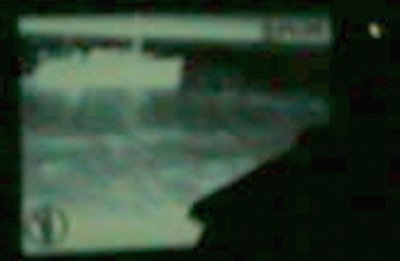
Tony and Eric both got a lot more interested. The boat we were closing on had turned off nearly all the exterior lights and it was now almost invisible in the immense black ocean in front of us.
After what seemed like another bronco-riding eternity, we finally came close enough for the FLIR screen to pick up the boat. It was a fishing boat heading north away from the Newport coastline.
Again, Tony and Eric determined that the boat not worthy of further interest, and we turned around and headed south, back towards Newport Harbor. Tony and Eric continued to scan the radar for suspect boats that might be of interest.
We sped past Newport Harbor and headed south over the waters off Laguna Beach. Our destination was Dana Poin, where the crew would take a lunch break. Lunch on this mission would take place at the OCSD Dana Point Harbor base shortly after 2 a.m.
Various blips appeared on the radar in front of Eric as we made our way to Dana Point. To my untrained eye this stretch of water seemed devoid of any boat traffic. As we made our way south, we saw no boats of interest. I guessed I was starting to see what Tony and Eric’s well-trained eyes already knew.
Pulling into Dana Point harbor, the constant banging on our hull turned instantly into pure silence as we rounded the breakwater. Nothing seemed to move or make a sound. Only the sound of our patrol boat’s wake could be heard as we headed into the dock.
The crew tied up the boat and headed inside to have lunch. Lucky for me, Tony invited me inside to join them. I was glad they did. Although I had prepared for a cold night on the water, my three layers under my windbreaker wouldn’t have lasted me long outside that night.
As the crew broke out their meals, Jose talked about how he grew up in Santa Ana. His better half is a teacher in a nearby O.C. city. He mentioned how he had gone to the Border Patrol’s academy in New Mexico. We joked about Roswell, New Mexico, the home of all things UFO, and a place called Alamogordo. Both of us had traveled there before.
We finished lunch and headed back to the boat. As we slipped out of Dana Point we headed north back towards Newport Beach along the coastline. As the clock ticked away the minutes and hours, the crew’s routine returned to scanning the radar and FLIR for any suspicious contacts.
The sounds of the ocean swells pounding the aluminum hull of our sleek high-tech patrol boat were a constant that night. The occasional radio calls were the only breaks in the silent search.
Sometime after 4 a.m. our captain, Anthony, turned on his cell phone and tuned into a local radio station via Pandora. The near silence of the evening was now being broken by the sounds of the classic Motown hit “I Heard It Through the Grapevine.” I welcomed the music as more songs played and our search and patrol mission continued north of Newport.
As the night wore on Tony and Eric’s eyes scanned the horizon and the radar and FLIR screens as we sped north in search of suspicious activity. Although by the end of this night we didn’t make ‘contact’ with any confirmed smuggling activity, it was clear this Operation Stonegarden crew of three was ready if and when they did.
As we returned to Newport Harbor just before 6 a.m., I asked Tony about any other smuggling patrols he had been on where “contact” had been made with his adversary. It turned out he had been one of the OCSD deputies who had been in the right place at the right time when smugglers had dropped off a panga full of people at Huntington Beach and had tried to make their escape.
Tony, to my surprise, told me he had been involved and had chased down the smugglers and arrested them at sea. A photo of Tony and another deputy, guns drawn, had splashed across the news media in that case. The smugglers’ panga, Tony told me, “tried some evasive maneuvers, but we ultimately got them.”
That incident had happened prior the Sheriff’s Department getting the new boat that Tony and his crew were now using
After spending more than six hours in the dead of night on this Operation Stonegarden patrol, with three dedicated officers trying to stem the tide of illegal human and drug smuggling along the OC coast, I was certain about one thing: chasing down smugglers would be lot easier with their new high-tech, high-speed boat than it had been in old patrol boats that were more than a decade old.
On this night no smugglers were to be found. But they were surely out there. The ocean is a very big place and this was only one night for this crew – the search would continue on many missions to come.
Photos by Eric Longabardi



